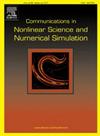Spurious mode identification method under a variable spacing finite difference framework for the stability equation based on the Boltzmann-BGK model
IF 3.4
2区 数学
Q1 MATHEMATICS, APPLIED
Communications in Nonlinear Science and Numerical Simulation
Pub Date : 2025-02-15
DOI:10.1016/j.cnsns.2025.108682
引用次数: 0
Abstract
The theory of rarefied flow stability analysis provides essential theoretical support for predicting high-altitude transitions in aircraft and enhancing the performance of micro-electro mechanical systems (MEMS), offering significant scientific and engineering value. This paper introduces a linear stability analysis method based on a finite difference method of the Boltzmann-BGK model, applicable to flows ranging from rarefied to continuous. The method demonstrates high computational efficiency, achieving nearly threefold improvement over spectral method commonly used in stability analysis. As gas rarefaction increases, the efficiency gains become more pronounced. However, spurious spectra may emerge when calculating eigenvalues with finite difference methods. Stability analysis of rarefied Couette flow over a flat plate reveals that increasing the finite difference method's order or modifying the spatial grid point distribution can quickly identify spurious modes. Aligning the grid distribution with the actual physical flow also enhances computational accuracy. Consequently, this difference method can provide high-quality computational results for high Mach number or strongly non-equilibrium flows.
稀流稳定性分析理论为预测飞机的高空过渡和提高微电子机械系统(MEMS)的性能提供了重要的理论支持,具有重大的科学和工程价值。本文介绍了一种基于 Boltzmann-BGK 模型有限差分法的线性稳定性分析方法,适用于从稀薄流到连续流的各种流动。该方法具有很高的计算效率,与稳定性分析中常用的光谱法相比,计算效率提高了近三倍。随着气体稀薄度的增加,效率的提高会更加明显。然而,用有限差分法计算特征值时,可能会出现虚假光谱。对平板上稀释的 Couette 流体进行稳定性分析后发现,增加有限差分法的阶数或修改空间网格点分布可以快速识别假模。使网格分布与实际物理流动一致也能提高计算精度。因此,这种差分法可以为高马赫数或强非平衡流动提供高质量的计算结果。
本文章由计算机程序翻译,如有差异,请以英文原文为准。
求助全文
约1分钟内获得全文
求助全文
来源期刊

Communications in Nonlinear Science and Numerical Simulation
MATHEMATICS, APPLIED-MATHEMATICS, INTERDISCIPLINARY APPLICATIONS
CiteScore
6.80
自引率
7.70%
发文量
378
审稿时长
78 days
期刊介绍:
The journal publishes original research findings on experimental observation, mathematical modeling, theoretical analysis and numerical simulation, for more accurate description, better prediction or novel application, of nonlinear phenomena in science and engineering. It offers a venue for researchers to make rapid exchange of ideas and techniques in nonlinear science and complexity.
The submission of manuscripts with cross-disciplinary approaches in nonlinear science and complexity is particularly encouraged.
Topics of interest:
Nonlinear differential or delay equations, Lie group analysis and asymptotic methods, Discontinuous systems, Fractals, Fractional calculus and dynamics, Nonlinear effects in quantum mechanics, Nonlinear stochastic processes, Experimental nonlinear science, Time-series and signal analysis, Computational methods and simulations in nonlinear science and engineering, Control of dynamical systems, Synchronization, Lyapunov analysis, High-dimensional chaos and turbulence, Chaos in Hamiltonian systems, Integrable systems and solitons, Collective behavior in many-body systems, Biological physics and networks, Nonlinear mechanical systems, Complex systems and complexity.
No length limitation for contributions is set, but only concisely written manuscripts are published. Brief papers are published on the basis of Rapid Communications. Discussions of previously published papers are welcome.
 求助内容:
求助内容: 应助结果提醒方式:
应助结果提醒方式:


